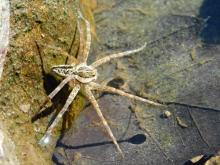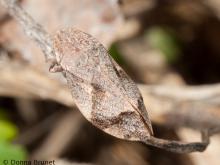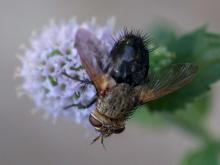Land Invertebrates
Media

Species Types
Scientific Name
Dolomedes scriptus
Description
The striped fishing spider feels vibrations on the water surface to detect the movements of prey, then skates across the water to grab and subdue it. Like most other fishing spiders, it can also go underwater to capture small fish and other small aquatic animals.
Media

Species Types
Scientific Name
8 tribes, with about 23 genera, in North America north of Mexico
Description
Millipedes in family Xystodesmidae often have bright colors that serve as a warning to potential predators that they may secrete foul or toxic substances.
Media

Species Types
Scientific Name
Lepyronia quadrangularis
Description
The diamondback spittlebug is common in weedy areas. The larvae live protected in spitty masses of foam. The adults are drab and well camouflaged, so few people notice them.
Media

Species Types
Scientific Name
Neoscona crucifera
Description
A widespread species, the barn spider commonly builds its webs in woods and on the eaves of barns, houses, and similar structures.
Media

Species Types
Scientific Name
Neoscona arabesca
Description
The arabesque orbweaver is a common orb-weaving spider in Missouri. The coloration is quite variable, but the slanting dark marks on the abdomen help to identify it.
Media

Species Types
Scientific Name
Cinindela repanda
Description
The bronzed tiger beetle is usually seen patrolling the shores of creeks, rivers, and other bodies of water, in open areas with sand, gravel, or clay soils.
Media

Species Types
Scientific Name
Curculio spp.
Description
Nut and acorn weevils, in genus Curculio, have very long, narrow beaks and chunky bodies. Females bore tiny holes into developing acorn, hickory, or other nuts, and deposit their eggs within.
Media

Species Types
Scientific Name
About 1,350 species in North America north of Mexico
Description
Tachinid flies are one of the largest families of flies. They are parasitic flies whose larvae are parasitoids of other insects. They look a lot like house flies, blow or bottle flies, wasps, or bees. Many are very bristly.
Media

Species Types
Scientific Name
More than 1,200 species in North America north of Mexico
Description
Andrenid bees, also called mining bees, are solitary ground-nesters. Most are specialist pollinators whose life cycle is timed to correspond precisely to the blooming of specific flowers.
Media

Species Types
Scientific Name
Ommatius spp.
Description
Ommatius robber flies are medium-sized robber flies with distinctively branching antennae. There are about four of five species that might occur in Missouri.
See Also



Media

Species Types
Scientific Name
Cisseps fulvicollis
Description
The yellow-collared scape moth is more often “orange-collared.” And whether you think it looks more like a firefly or a wasp, it’s still a moth!
Media

Species Types
Scientific Name
Nearly 150 species in North America north of Mexico
Description
Slim, delicate plume moths are instantly recognizable by their T-shaped silhouette, long legs, and muted shades of tan and brown. It can be hard to separate the various species.
Media

Species Types
Scientific Name
Pyrrharctia isabella
Description
Not many people know the adult Isabella tiger moth when they see one, but we’re all acquainted with its caterpillar, the woolly worm, or woolly bear.
About Land Invertebrates in Missouri
Invertebrates are animals without backbones, including earthworms, slugs, snails, and arthropods. Arthropods—invertebrates with “jointed legs” — are a group of invertebrates that includes crayfish, shrimp, millipedes, centipedes, mites, spiders, and insects. There may be as many as 10 million species of insects alive on earth today, and they probably constitute more than 90 percent all animal species.





















